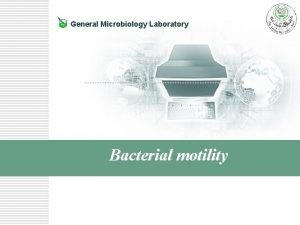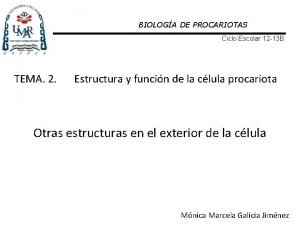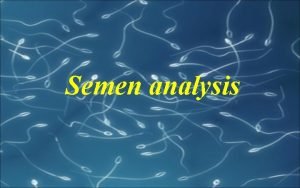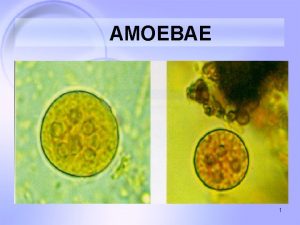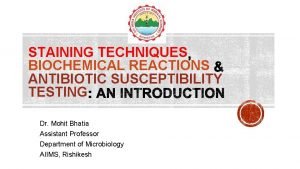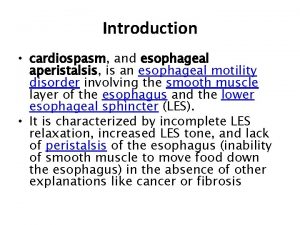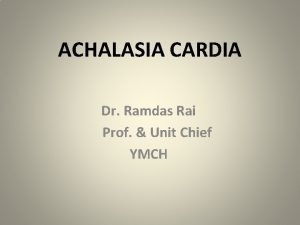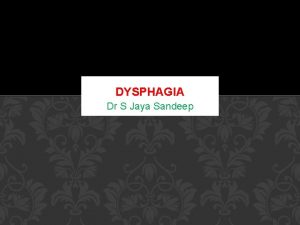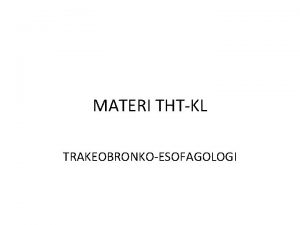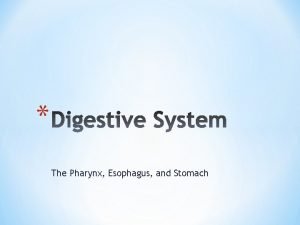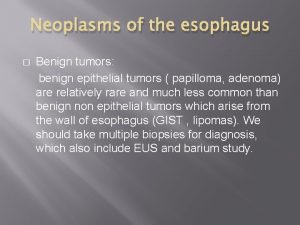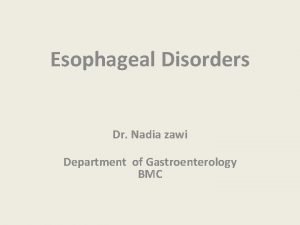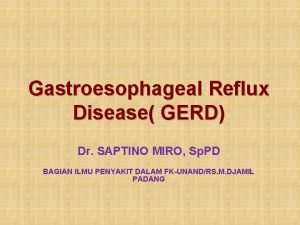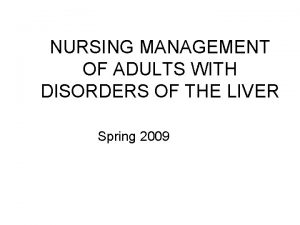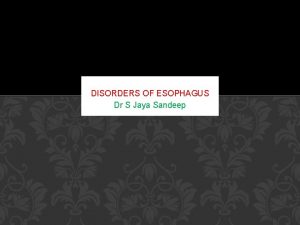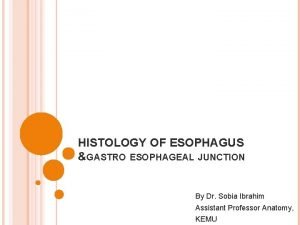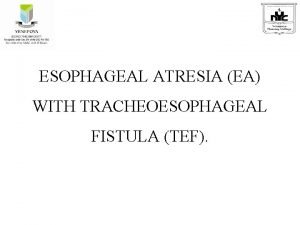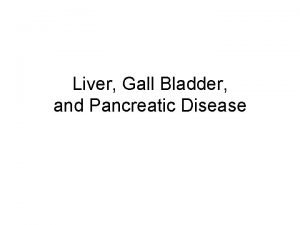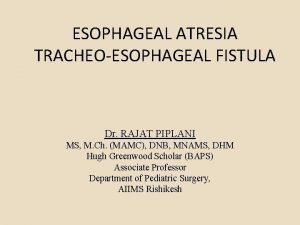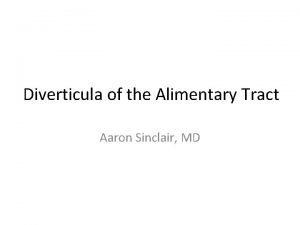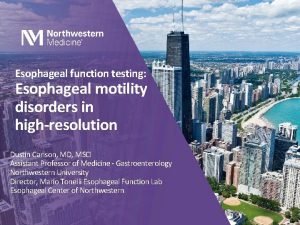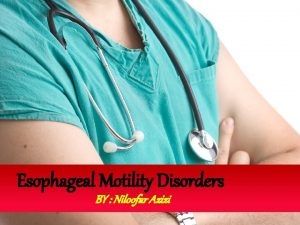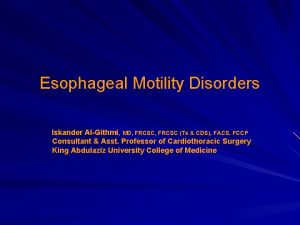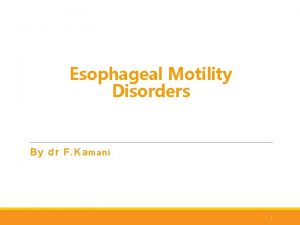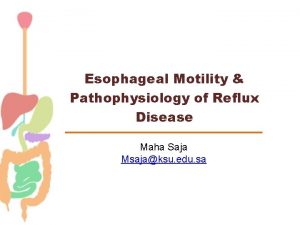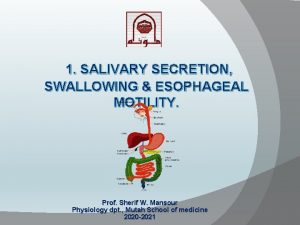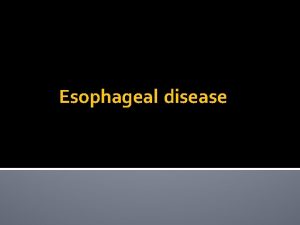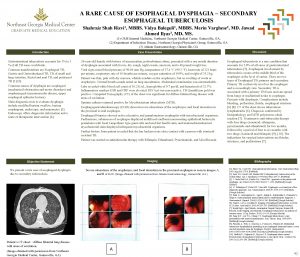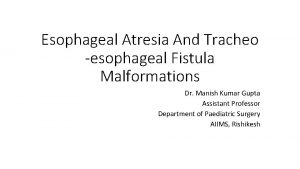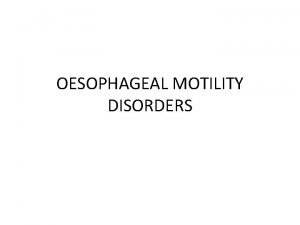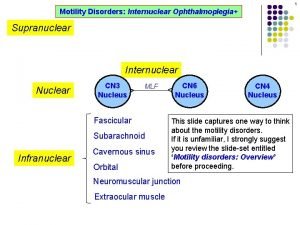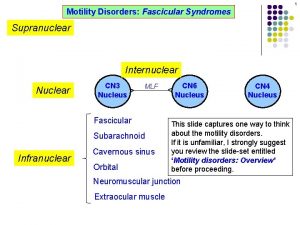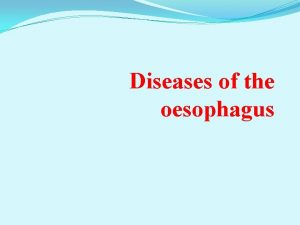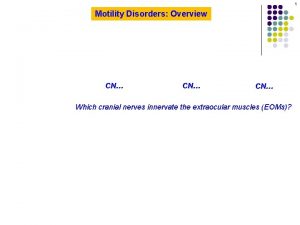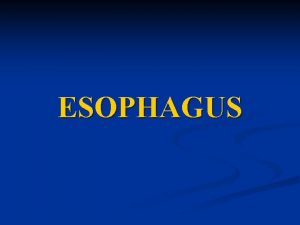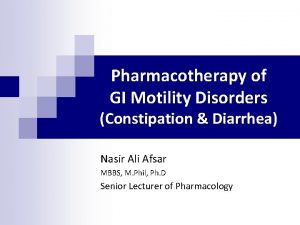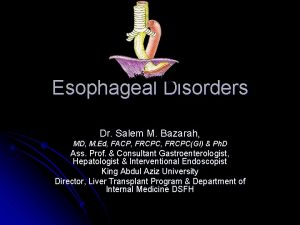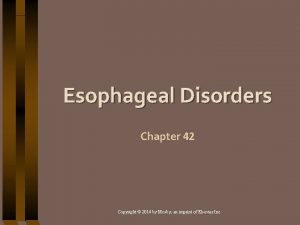Esophageal Motility Disorders Esophageal Motility Dz Esophageal Disorders

























- Slides: 25

Esophageal Motility Disorders

Esophageal Motility Dz Esophageal Disorders • • • Motility Anatomic & Structural Reflux Infectious Neoplastic Miscellaneous

Esophageal Motility Dz Esophageal Anatomy Upper Esophageal Sphincter (UES) Esophageal Body (cervical & thoracic) Lower Esophageal Sphincter (LES) 18 to 24 cm

Esophageal Motility Dz Normal Phases of Swallowing • Voluntary – oropharyngeal phase – bolus is voluntarily moved into the pharynx • Involuntary – UES relaxation – peristalsis (aboral movement) – LES relaxation • Between swallows – UES prevents air entering the esophagus during inspiration and prevents esophagopharyngeal reflux – LES prevents gastroesophageal reflux – peristaltic and non-peristaltic contractions in response to stimuli – capacity for retrograde movement (belch, vomiting) and decompression

Esophageal Motility Dz Normal Swallowing Frontal cortex Cortical Swallowing Areas Swallowing Center Brainstem Motor Nuclei Oropharynx & Esophagus

Esophageal Motility Dz Motility Disorders • upper esophageal – UES disorders – neuromuscular disorders • esophageal body – – achalasia diffuse esophageal spasm nutcracker esophagus nonspecific esophageal dysmotility • LES – achalasia – hypertensive LES • primary disorders – – achalasia diffuse esophageal spasm nutcracker esophagus nonspecific esophageal dysmotility • secondary disorders – – – severe esophagitis scleroderma diabetes Parkinson’s stroke

Esophageal Motility Dz Motility Disorders • diagnostic tools – – cineradiology or videofluoroscopy (MBS) barium esophagram esophageal manometry endoscopy

Esophageal Motility Dz Normal Manometry

Esophageal Motility Dz Upper Esophageal Motility Disorders • cause oropharyngeal dysphagia (transfer dysphagia) – patients complain of difficulty swallowing – tracheal aspiration may cause symptoms • pharyngoesophageal neuromuscular disorders – – – – stroke Parkinson’s poliomyelitis ALS multiple sclerosis diabetes myasthenia gravis dermatomyositis and polymyositis • upper esophageal sphincter (cricopharyngeal) dysfunction

Esophageal Motility Dz UES Disorders • cricopharyngeal hypertension – elevated UES resting tone – poorly understood (reflex due to acid reflux or distension) • cricopharyngeal achalasia – incomplete UES relaxation during swallow – may be related to Zenker’s diverticula in some patients • clinical manifestations – localizes as upper (cervical) dysphagia – within seconds of swallowing – coughing, choking, immediate regurgitation, or nasal regurgitation • diagnosis: swallow evaluation & modified barium swallow

Esophageal Motility Dz Motility Disorders of the Body & LES • symptoms: usually dysphagia (intermittent and occurring with liquids & solids) • diagnostic tests – barium esophagram – endoscopy – esophageal manometry • disorders – – – achalasia diffuse esophageal spasm (DES) nutcracker esophagus hypertensive LES nonspecific esophageal dysmotility • hypomotility • hypermotlity

Esophageal Motility Dz Achalasia • first clinically recognized esophageal motility disorder • described in 1672, treated with whale bone bougie • term coined in 1929 • dual disorder – LES fails to appropriately relax • resistance to flow into stomach • not spasm of LES but an increased basal LES pressure often seen (55 -90%) – loss of peristalsis in distal 2/3 esophagus

Esophageal Motility Dz Achalasia • epidemiology – – – 1 -2 per 200, 000 population usually presents between ages 25 to 60 male=female Caucasians > others average symptom duration at diagnosis: 2 -5 years • pathology – loss of ganglionic cells in the myenteric plexus (distal to proximal) – vagal fiber degeneration – underlying cause: unknown • autoimmune? (antibodies to myenteric neurons in 50% of patients)

Esophageal Motility Dz Achalasia • clinical presentation – – – solid dysphagia 90 -100% (75% also with dysphagia to liquids) post-prandial regurgitation 60 -90% chest pain 33 -50% pyrosis 25 -45% weight loss nocturnal cough and recurrent aspiration • diagnosis – plain film (air-fluid level, wide mediastinum, absent gastric bubble, pulmonary infiltrates) – barium esophagram (dilated esophagus with taper at LES) • good screening test (95% accurate) – endoscopy (rule out GE junction tumors, esp. age>60) – esophageal manometry (absent peristalsis, LES relaxation, & resting LES >45 mm. Hg)

Esophageal Motility Dz Achalasia • treatment - reduce LES pressure and increase emptying – nitrates and calcium channel blockers • 50 -70% initial response; <50% at 1 year • limitations: tachyphylaxis and side-effects – botulinum toxin (prevents ACH release at NM junction) • 90% initial response; 60% at 1 year – pneumatic dilation (disrupt circular muscle) • 60 -95% initial success; 60% at 5 years • recent series suggest 20 -40% will require re-dilation • risk of perforation 1 -13% (usually 3 -5%); death 0. 2 -0. 4% – surgical myotomy (open or minimally-invasive) • >90% initial response; 85% at 10 years; 70% at 20 years (85% at 5 years with min. inv. techniques) • <1% mortality; <10% major morbidity • 10 -25% acutely develop reflux, up to 52% develop late reflux

Esophageal Motility Dz Spastic Motility Disorders of the Esophagus • “lumper” approach – normal – achalasia – spastic motility disorder • “splitter” approach (radiology and manometry) – – diffuse esophageal spasm nutcracker esophagus hypertensive LES nonspecific esophageal dysmotility • “splitting” has not resulted in a clinical benefit

Esophageal Motility Dz Diffuse Esophageal Spasm • frequent non-peristaltic contractions – simultaneous onset (or too rapid propagation) of contractions in two or more recording leads – occur with >30% of wet swallows (up to 10% may be seen in “normals”)

Esophageal Motility Dz Nutcracker Esophagus • high pressure peristaltic contractions – avg pressure in 10 wet swallows is >180 mm Hg • 33% have long duration contractions (>6 sec) • may inter-convert with DES

Esophageal Motility Dz Hypertensive LES • high LES pressure – >45 mm Hg • normal peristalsis • often overlaps with other motility disorders Nonspecific Esophageal Dysmotility • abnormal motility pattern • fits in no other category – non-peristalsis in 2030% of wet swallows – low pressure waves (<30 mm Hg) – prolonged contractions

Esophageal Motility Dz Spastic Motility Disorders of the Esophagus • epidemiology – any age (mean age 40) – female > male • symptoms – dysphagia to solids and liquids • intermittent and non-progressive • present in 30 -60%, more prevalent in DES (in most studies) – chest pain • constant % across the different disorders (80 -90%) • swallowing is not necessarily impaired • can mimic cardiac chest pain – pyrosis (20%) and IBS symptoms (>50%) – symptoms and manometry correlate poorly

Esophageal Motility Dz Spastic Motility Disorders of the Esophagus • diagnosis – – manometry barium esophagram endoscopy p. H monitoring • treatment – reassurance – nitrates, anticholinergics, hydralazine - all unproven – calcium channel blockers - too few data with negative controlled studies in chest pain – psychotropic drugs – trazodone, imipramine and setraline effective in controlled studies – dilation - anecdotal reports, probable placebo effect

Esophageal Motility Dz Manometry in Esophageal Symptoms Non-Cardiac Chest Pain Dysphagia JE Richter, Ann Int Med, 1987

Esophageal Motility Dz Hypomotilty Disorders • primary (idiopathic) – aging produces gradual decrease in contraction strength – reflux patients have varying degrees of hypomotility • more common in patients with atypical reflux symptoms • usually persists after reflux therapy – defined as • low contraction wave pressures (<30 mm Hg) • incomplete peristalsis in 30% or > of wet swallows

Esophageal Motility Dz Hypomotilty Disorders • secondary – scleroderma • in >75% of patients • progressive, resulting in aperistalsis in smooth-muscle region • incompetent LES with reflux – other “connective tissue diseases” • CREST • polymyositis & dermatomyositis – diabetes • 60% with neuropathy have abnormal motility on testing (most asx) – other • hypothyroidism, alcoholism, amyloidosis

Esophageal Motility Dz Nonischemic Chest Pain • remains poorly understood (functional chest pain) • enthusiastic investigation finds numerous associations in studies – – psychiatric disorders (depression, panic or anxiety disorder…) esophageal disorders (GERD, motility disorders…) musculoskeletal disorders cardiac disease (microvascular, MVP, tachyarrhythmias…) • GERD is by far the most common, diagnosable, esophageal cause – – 50 -60% of patients have heartburn or acid regurgitation symptoms 50% have abnormal esophageal p. H studies (not always correlating to sxs) very low incidence of endoscopic findings “PPI Test” may be best and most cost-effective approach • a small subset of patients with non-GERD NCCP display a variety of esophageal motility disorders – symptoms and motility findings correlate poorly – esophageal hypersensitivity/hyperalgesia may explain the symptoms
 Tsi
Tsi Hanging drop method diagram
Hanging drop method diagram Gliding motility
Gliding motility Normal semen report
Normal semen report Cutaneous amebiasis
Cutaneous amebiasis üyou
üyou Motility vs mobility
Motility vs mobility Fermentation test bacteria
Fermentation test bacteria Motility test positive and negative
Motility test positive and negative Aperistalsis
Aperistalsis Triad of achalasia cardia
Triad of achalasia cardia Esophageal web
Esophageal web Odynophagia
Odynophagia Anatomi trakea
Anatomi trakea Stomach labeled
Stomach labeled Zinkers diverticula
Zinkers diverticula Esophageal dysmotility
Esophageal dysmotility Esophageal manometry
Esophageal manometry Nursing management of liver abscess
Nursing management of liver abscess Varus esophagus
Varus esophagus Histology of gastroesophageal junction
Histology of gastroesophageal junction Tef types
Tef types Esophageal varices
Esophageal varices Lung impressions mnemonic
Lung impressions mnemonic Tef classification
Tef classification Dr aaron sinclair
Dr aaron sinclair

